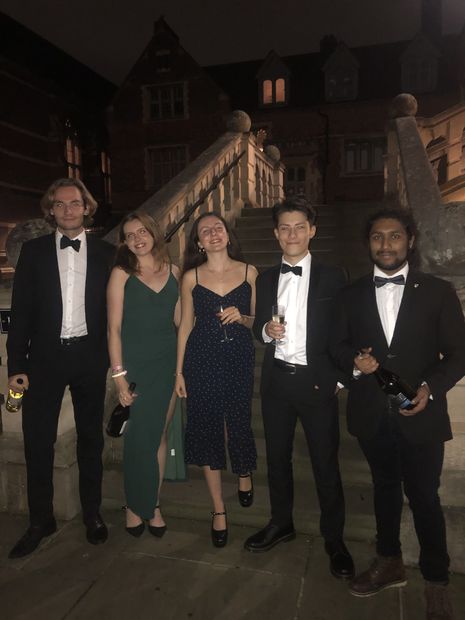Not a ‘Cambridge experience’?
Looking at the change in public spaces and ways of socialising, Juliette Guéron-Gabrielle reflects on her experience of university last year during the pandemic

Last year, a series of lockdowns and public health recommendations led to the reorganisation of almost every public space possible — from means of transport, to workplaces, to restaurants. Mostly, this reorganisation was a distancing: the closing off of the possibility of brushing against one’s neighbour's elbow while eating, or of knocking down their glass while making emphatic gestures. It made social interactions neater and drier by suppressing the possibility of physical closeness. It made the public place prescriptive and normative: subway seats bearing large red crosses and DO NOT SIT signs; arrows in supermarkets devising a single acceptable route through the store; glass panels separating groups of customers at pubs.
However, this rapid reorganisation of space on the part of institutions hoping to stay open legally forced some spaces to escape their initial purpose, and instead to serve new functionalities. To stay open, Selwyn Hall, for instance, broke up its long, wooden tables where students used to pile up and mingle across friendship groups, and replaced them with smaller tables for households only. Hall turned from being a place where proximity was enforced, in the Cambridge ideal of a tight community sharing a single way of life, into a place where people sat down with their pre-existing group and left without interacting with anyone new.
“I do not think that last year should be considered not a ‘Cambridge experience’”
This was both reassuring for those that did not appreciate having to make small talk during very mundane moments of their life — like their daily meals — but also saddening: unexpected chats are what made the charm of campus life. Last week, I felt so happy watching one of my (particularly jittery) friends bouncing up and down the long wooden tables of Selwyn Hall so he could speak to everyone attending his birthday formal. Each time I turned my head, he had switched places with someone and easily fallen into conversation with a new group of two or three people. Observing the return of short, bantery conversations in Hall truly made it feel like the ‘normal’ Selwyn was back. However, the social proximity of long, wooden tables also has its drawbacks. Another one of my friends complained about the new tables, stating they had forced him to chat with someone over breakfast. Objectively, breakfast does sound a little bit early for forced conversation with quasi-strangers.
It is interesting, then, to observe the post-COVID reintroduction of small talk, be it over the long tables in hall, or in Rev’s smoking area (I would have preferred to write ‘Cindies’’ but I need to keep up with the times). When I was in high school, my friend Gabrielle refused to go to Starbucks because she had just watched a documentary on the chain. I watched it and was struck when the narrator, speaking of the men that had developed the branding of the coffee chain, said they had “invented the place where one could be alone in public”. They had subverted the traditional function of a coffee shop — a ‘tier-lieu’, a space in between the house and the workplace where people can interact — and made it into a kind of extension of the home: a public place for private, separate behaviour.
“... ‘traditional’ use of spaces are not essential to having a Cambridge experience”
The pandemic made it the norm for individuals to appear alone in public, or in small groups. Now the norm is reverting back to pre-COVID days: one goes to hall to socialise, even over breakfast, not to eat alone. Never again will caterers come into Hall and ask us to leave because all the ‘household’ tables are full, or ask me what my room number is to verify that I am eating with my household. Now, social contact and interaction goes unquestioned, which feels refreshing.
During COVID, it was interesting to watch high-table fall mostly into disuse because of its inability to accommodate social distancing. The pandemic upended the very formal hierarchy of Cambridge dining — an interesting reminder that all the ‘traditions’ and ‘traditional’ use of spaces are not essential to having a Cambridge experience. It was still a Cambridge hall, but everyone was eating at the same geographical level.
These last weeks, I keep hearing (and, admittedly, saying) how good it is to have ‘Cambridge’ back. By this I mean the formals, the house parties, the pres, club nights, Van of Life expeditions — almost all of what we had in Easter plus the clubs and minus the stress of exams.
I like seeing how happy my friends look now that we can engage in all the Cambridge rituals we were taught in first year; now that the traditional organisation of college spaces has resumed; and, most of all, I am so happy to be back for third year. But I do not think that last year should be considered not a ‘Cambridge experience’, especially for those who, like me, spent Lent term in college instead of at home.
It was a different Cambridge: a Cambridge that had to adapt to outside circumstances, upend its traditional hierarchies and organisation of space, and rethink its century-long traditions in the face of an emergency. When we, in the future, all have more foresight, it will be interesting to reflect on what Cambridge looked like when it was forced to radically and rapidly adapt to the world, instead of, as is sometimes the case, having the world adapt to Cambridge.
 News / Cambridge academics stand out in King’s 2026 Honours List2 January 2026
News / Cambridge academics stand out in King’s 2026 Honours List2 January 2026 Interviews / You don’t need to peak at Cambridge, says Robin Harding31 December 2025
Interviews / You don’t need to peak at Cambridge, says Robin Harding31 December 2025 Comment / What happened to men at Cambridge?31 December 2025
Comment / What happened to men at Cambridge?31 December 2025 News / Varsity’s biggest stories of 202531 December 2025
News / Varsity’s biggest stories of 202531 December 2025 Features / “It’s a momentary expression of rage”: reforming democracy from Cambridge4 January 2026
Features / “It’s a momentary expression of rage”: reforming democracy from Cambridge4 January 2026










